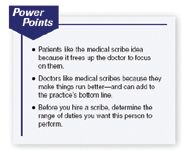Article
What a scribe can do for you
Doctors with aching fingers have found a good way to relieve their documentation woes. Will their idea work for you, too?

The reason Krefting can demand his patients' full attention-and give them his-is simple: As he speaks, his medical assistant sets down the important points he makes in the medical record. After Krefting leaves, this same person stays behind, going over his instructions, preparing a sheet for patients to take home, and answering any questions about insurance and coverage that might arise. "I tell patients I'm here to do the medicine-the scribe will take care of the other business," Krefting says.
Other doctors are telling their patients the same thing-and patients seem to be happy. They like the medical scribe idea because it frees up their doctors to focus more exclusively on them. And doctors like it because it lightens their documentation burden; makes visits go more efficiently; and can sometimes even fatten their bottom line, either through increased productivity or better coding.
"The practice of medicine has already become too impersonal," says Donald A. Fuesler, a GP in Longview, WA, "and this kind of thing just adds to the problem." Others say that having medical scribes in the exam room undermines confidentiality, intrudes on the doctor-patient relationship, and leads to higher costs. Some raise another issue: "I don't see any reason to use scribes because I find typing into the EHR fairly fast," says FP Stefan Topolski, who practices in Shelburne Falls, MA.
Topolski has a point. As more practices adopt EHRs, today's medical scribes could very well go the way of their medieval counterparts in the age of Gutenberg. But some experts argue the opposite could also happen, especially if doctors who purchase the new technology are slow to use it and want someone to fill-in, at least to type free text.
"I don't think scribes will go the way of the dinosaur," says Judy Bee, a practice management consultant in La Jolla, CA. "In fact, I wouldn't be surprised if the proliferation of EHRs increases their use, at least at the beginning." As for doctors' other concerns about confidentiality, costs, and intrusions on the doctor-patient relationship, Bee thinks those can be addressed, too.
Can they? We talked to doctors who use medical scribes to weigh the pros and cons.
Lights on or off-scribes can boost your efficiency
Bee first encountered office-based scribes in the ophthalmology practices she visited, where necessity was really the mother of invention.
"When the ophthalmologic exam is going on, the lights are off, and the doctor is nose to nose with his patient," says Bee. "Under these conditions, it's literally a pain in the neck to have to turn around and write things down in the chart. A scribe, on the other hand, can sit where there's enough light and record what the doctor's saying to his patient.
"Once the lights are back on and the doctor begins to outline what, if anything, needs to be done, the scribe can also document the treatment plan. If the doctor prescribed medications, she might prepare a preprinted script with the patient's name and the date. Then, as the doctor writes up the prescription, checks and signs the chart, and says goodbye to his patient, the scribe's off to where the doctor is scheduled to be next."





